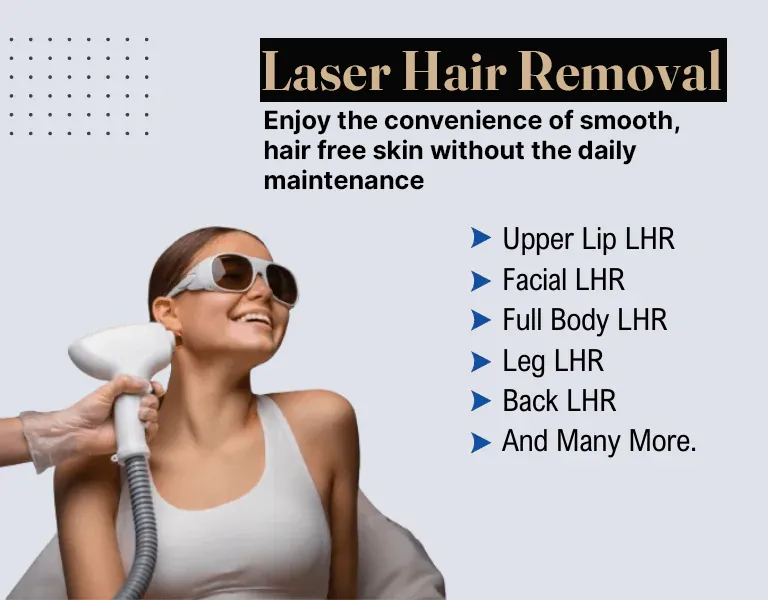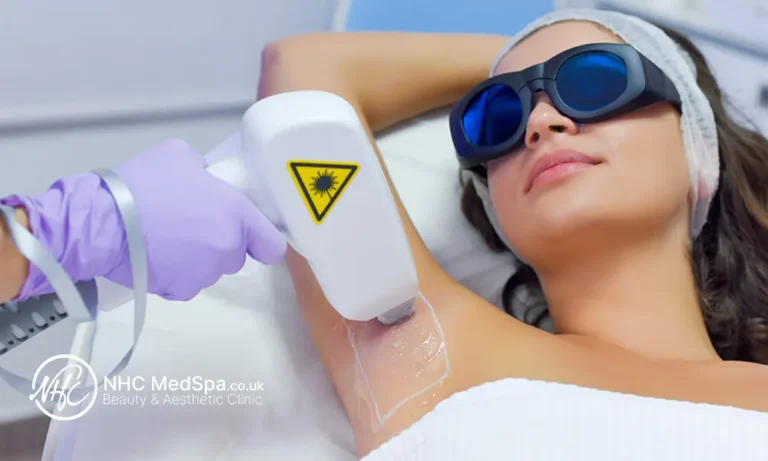Laser Hair Removal
NHC MedSpa in London offers premium laser hair removal services, utilizing the latest pain-free laser technology for outstanding results.
This advanced diode laser system ensures a virtually painless experience with a high safety standard. Setting itself apart from other hair removal methods, it’s effective on all skin types, including tanned skin, delivering smooth and lasting results.
The innovative hand-piece of the laser reaches various depths within the hair follicle simultaneously, combining three different wavelengths to maximize the efficacy of each treatment.

We have a special discount for laser hair removal. You can refer to the special offers page to see this exceptional discount.
FAQ : Laser hair removal
The laser light safely and gently penetrates the skin, targeting the hair root to destroy the cells responsible for hair growth. By absorbing the laser energy directly into the hair follicle, it effectively prevents hair from regrowing without harming the surrounding skin.
is the safest procedure available for laser hair removal, also approved by the FDA (Food & Drug Administration) for all skin types (including tanned skin), hair types, and most hair colours.
At our North London clinic, we use the latest technology for effective and permanent hair removal. Our advanced lasers offer a virtually painless experience, helping you achieve smooth, hair-free skin with long-lasting results.
Typically we recommend a minimum of six laser sessions for women.
Why it’s done
Laser hair removal is popular for reducing unwanted hair on various body parts, including the legs, armpits, upper lip, chin, and bikini line. It can target almost any area except around the eyes and tattooed skin, which shouldn’t be treated.
The success of laser hair removal depends on hair color and skin type. The laser works by focusing on the pigment in the hair, not the skin, targeting the hair follicle while preserving the surrounding skin. Dark hair on light skin yields the best results, though advancements in technology now make laser hair removal possible for people with darker skin. However, it remains less effective for gray, red, blonde, and white hair, though new options are emerging for these lighter colors.
Risks
Side effects can vary based on skin type, hair color, and treatment specifics, as well as adherence to pre- and post-care guidelines. Common side effects include:
- Skin irritation: Temporary redness, swelling, or discomfort usually subsides within hours.
- Pigment changes: Treated areas may temporarily darken or lighten, especially in people with darker skin or those exposed to the sun right before or after treatment.
- Rarely, blistering, scarring, changes in skin texture, or hair graying can occur. Unwanted hair growth around treated areas is also possible, especially for darker skin tones.
Laser hair removal is generally not recommended near the eyes due to the risk of severe injury.
Preparing for Laser Hair Removal
Choosing a board-certified dermatologist or experienced cosmetic surgeon is important for laser hair removal. If someone other than a doctor performs the procedure, ensure they are supervised by one on-site. Be cautious with spas or salons where nonmedical personnel might conduct the treatment.
Before starting, schedule a consultation to confirm whether laser hair removal is suitable for you. The doctor will likely:
- Review your medical history, medication use, skin conditions, and previous hair removal attempts.
- Discuss possible outcomes, including what laser hair removal can and can’t achieve.
- Take photos for comparing results over time.
During the consultation, your doctor will outline a treatment plan and provide guidelines on how to prepare. This may include:
- Avoiding sun exposure: Use an SPF 30+ sunscreen when outdoors.
- Skipping tanning products: Avoid any self-tanners before treatment.
- Avoiding certain hair removal methods: Refrain from plucking, waxing, or electrolysis for at least four weeks prior.
- Avoiding blood-thinning medications: Consult with your doctor regarding any medications to avoid.
- Shaving the treatment area: Shaving before the procedure protects the skin by removing hair above the surface.
What to Expect During and After Laser Hair Removal
Laser hair removal typically requires multiple sessions, spaced according to hair growth cycles. Areas with fast hair growth, like the upper lip, may need treatments every 4–8 weeks, while slower-growing areas, like the back, may be treated every 12–16 weeks.
During each session, you’ll wear goggles for eye protection. The doctor may use a cooling device or gel to protect your skin and minimize side effects. When the laser is applied, you might feel a warm, pinprick sensation. Small areas can be treated in minutes, but larger areas, like the back, may take over an hour.
After treatment, some redness and swelling are common. Applying ice can help with any discomfort, and steroid creams may be used if there’s a skin reaction. Sun avoidance and daily sunscreen use are crucial between treatments to protect the treated areas.
Results and Maintenance
Laser hair removal results vary and don’t usually lead to permanent hair loss, but most people experience a lasting reduction. Treated hairs will fall out gradually over days to weeks, and regrowth is often finer and lighter. Maintenance treatments may be required to sustain results.
Home Laser Hair Removal Devices
Home laser devices can offer mild hair reduction, but they’re not as powerful as professional treatments. These devices are FDA-cleared for cosmetic use, so they undergo less rigorous testing compared to medical devices. Long-term safety and effectiveness data for home lasers is still limited.
If using a home device, carefully follow the instructions to minimize the risk of injury, especially to the eyes.




